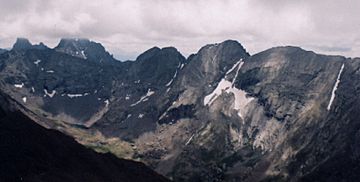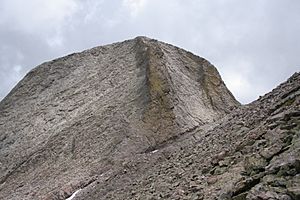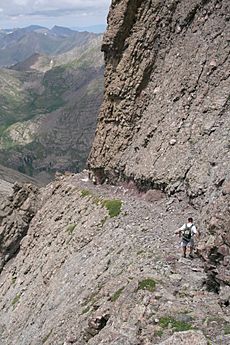Kit Carson Peak facts for kids
Quick facts for kids Kit Carson Mountain |
|
|---|---|
| Kit Carson Peak | |

The Crestones as seen from Mount Adams.
From left to right: Crestone Needle, Crestone Peak, Columbia Point, Kit Carson Peak, and Challenger Point. |
|
| Highest point | |
| Elevation | 14,171 ft (4,319 m) |
| Prominence | 1,025 ft (312 m) |
| Isolation | 1.27 mi (2.04 km) |
| Listing | Colorado Fourteener 23rd |
| Geography | |
| Location | Saguache County, Colorado, United States |
| Parent range | Sangre de Cristo Range, Crestones |
| Topo map | USGS 7.5' topographic map Crestone Peak, Colorado |
| Climbing | |
| Easiest route | Scramble Class 2 |

Kit Carson Peak, also known as Kit Carson Mountain, is a very tall mountain in Colorado, United States. It's part of the Crestones, a group of high peaks in the Sangre de Cristo Range within the Rocky Mountains. This mountain is special because it's one of Colorado's "fourteeners," meaning its summit is over 14,000 feet (4,267 meters) high! Kit Carson Peak stands at 14,171 feet (4,319 meters) tall.
The mountain is named after Christopher Houston "Kit" Carson, a famous American frontiersman. The name "Kit Carson Mountain" can refer to the main summit or the entire mountain area, which includes three peaks: Columbia Point, Kit Carson Peak, and Challenger Point.
Contents
Mountain History and Naming
Protecting Kit Carson Mountain Land
In 2002, a big agreement helped protect the land around Kit Carson Mountain. A group called the Nature Conservancy bought a large area known as the Baca Ranch. This purchase helped to make the Great Sand Dunes National Park and Preserve much larger in 2004. As part of this deal, Kit Carson Mountain became part of the Sangre de Cristo Wilderness within the Rio Grande National Forest. This means the mountain and its surroundings are now protected wild areas.
Why the Name Kit Carson Was Debated
In 2011, there was a discussion about changing the mountain's name to Mount Crestone. The United States Board on Geographic Names decided not to change it. They worried it would cause confusion with other nearby peaks like Crestone Peak and Crestone Needle.
The idea to rename the mountain came up because of Kit Carson's historical actions. In the 1860s, Carson led a campaign to move Navajo Indians from their lands. This was a difficult time in history. Interestingly, many local people had already been calling the mountain "Crestone Peak" for a long time, even though that was the official name of a different mountain nearby.
Climbing Kit Carson Peak
Popular Climbing Routes
Climbing Kit Carson Peak is a challenging adventure. One common way to climb it starts from the west side of the mountain range. This route begins at the Willow Creek Trailhead, which is about 8,900 feet (2,713 meters) high. Climbers first reach Challenger Point, which is just west of Kit Carson Peak. To get from Challenger Point to Kit Carson Peak, climbers cross a path often called 'Kit Carson Avenue'. This whole trip is about 14 miles (22.5 kilometers) round-trip and involves climbing about 6,250 feet (1,905 meters) in elevation.
Another way to climb Kit Carson Peak is from the east side of the Sangre de Cristos. This route uses the South Colony Lakes access. Part of this trail is also used for Humboldt Peak. Climbers then travel along a ridge and plateau towards Kit Carson. On this route, they also climb a smaller peak called Columbia Point, which some people informally call "Kat Carson," before reaching the main summit.
Mountain Weather and Safety
Kit Carson Peak does not have any large glaciers. However, it has a patch of ice on its rugged north face that often stays frozen, even in dry years. During the summer, the mountain and nearby peaks often experience thunderstorms. These storms can form quickly, and lightning strikes happen almost every day. It's very important for climbers to be aware of the weather and stay safe.
The mountain's terrain can be tricky, and climbers need to be careful. Sometimes, people try to take a shortcut down a steep gully (called a couloir) between the summit and Challenger Point. While it might look like an easy way down at first, this gully becomes very dangerous. It can lead to ice fields and steep cliffs with loose rocks, making it very difficult and risky to descend. It's crucial for climbers to stick to known, safer routes to avoid serious accidents.
Historical Names
- Frustum Peak
- Haystack Baldy
- Kit Carson Mountain – 1970
- Kit Carson Peak



